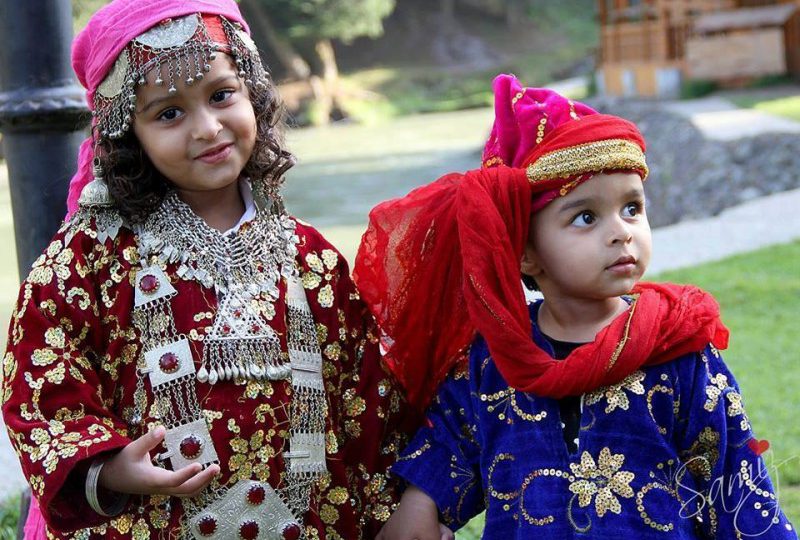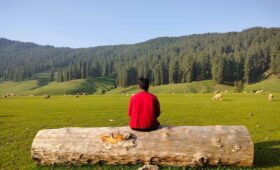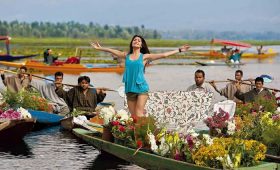How to Reach Kashmir
Traveling to Kashmir is quite easy and accessible as the valley is well connected to other parts of India with a well-developed network of roads, air and rail.
By Air Srinagar airport is approximately 14 km from the city. There are daily flights to Srinagar, operated by Indian Airlines (from Delhi, Mumbai and Jammu) and other Private Airlines like Air Deccan, SpiceJet, Kingfisher, Jet Airways (from Delhi and Jammu).
By Rail Jammu Tawi, approximately 305 km far, is the nearest railhead for Srinagar. Trains from Delhi, Calcutta, Pune, Mumbai and other cities arrive at this station only. During holiday season, when there is a heavy rush for Kashmir, additional trains operate for and from this station.
By Road National Highway 1-A is the main highway connecting Srinagar with Jammu. J&K State Road Transport Corporation (SRTC) as well as a number of private Super deluxe, A-class and B-class busses operate to and from the state. Private taxis are also available for traveling to Kashmir. This is one of the most adventurous though a bit strenuous travel track in India.
Accommodation in Kashmir
Kashmir is one of the most preferred tourist destinations in India. Every year, the Kashmir valley sees a large influx of tourists, domestic as well as foreign. As Kashmir has been a popular destination on the tourist map of India for a long time, finding accommodations is no big problem at any popular destination. You will get all types of accommodation facilities almost at every location. A number of hotels as well as houseboats count amongst the main places to stay in Kashmir. Other than that, there are also a number of guesthouses in the valley that provide cheap accommodation.
Houseboats
Houseboats (known as Shikaras locally) in Srinagar offer the tourists a unique experience. The luxury of staying on the serene water of a lake in a graceful boat, with all the services of a luxury hotel, draws many tourists to Srinagar. Most of the houseboats anchor along the banks of Dal Lake and Nagin Lake only. Just like hotels, the houseboats of Kashmir are also categorized. There are Deluxe, A-class, B-class, C-class and D-class houseboats in Srinagar.
Hotels
There are numerous hotels in Srinagar, located around the Dal Lake. Offering a comfortable stay to the tourists, these hotels provide breathtaking sights of the beautiful locales of Kashmir. There are numerous A-class, B-class and C-class hotels in Kashmir, each serving to the needs of a particular class of people.
Guest Houses In case you are looking for cheap accommodation, you will get numerous cheap and budget guesthouses not only in Srinagar but also other popular destinations in Kashmir valley.
Clothing, What to Wear?
The answer of “what to wear while traveling in Kashmir” depends upon the season in which you are visiting the valley. If you are visiting the Kashmir valley in summers, then it is better to wear cotton clothes. Although, like other places in India, Kashmir is not very hot in summers, still, the weather is a little bit warm. For spring season and autumn season, light woolens are the perfect clothes to wear in Kashmir. This is because in spring as well as autumn, cool breeze blows in the valley. The winters in Kashmir are cold and chilly. So, in this season heavy woolens are the answer to the question of “how to dress up” in Kashmir, India.
Electricity in Kashmir
he electric current in Kashmir is in the range of 240 Volts, at 50 cycles per second. In case you are getting electrical equipment that does not work at 240 Volts at 50 Hertz, then, do carry a voltage converter with you. As per the power and voltage in India, you may use the following three types of Voltage converters:
Resistor-network converters (for approximately 50 -1600 Watts support)
Transformers (for around 50 – 100 Watts support)
Combination converters (resistor network and transformer in the same package)
Another thing worth mentioning regarding electricity in Kashmir is the type of plug outlets. Outlets in Kashmir generally accept the two-round pins plug and three round pins lug, arranged in a triangle. In case of any other plug shape, you will need a plug adapter.
Money Exchange in Kashmir
The standard Indian rupee is the currency of the Kashmir valley as well. It is available in the denomination of Rs. 1, 2, 5, 10, 20, 50, 100, 500 and 1,000. For Rs. 1000, 500, 100, 50, 20 and 10, you will find currency notes only. While, Rs. 1, 2 and 5 are available both in notes as well as coins, even though you will find these denominations in notes rarely. You will find it convenient to carry money in small denomination also as it will help you in paying for your miscellaneous expenses. In case you fall short of currency and looking for money exchangers in your Kashmir trip, no need to panic as there are several money exchangers in Srinagar, Jammu and Leh towns of Kashmir valley.
Here is a list of some of the money exchangers in Srinagar city.
State Bank of India, Residency Road
Jammu & Kashmir Bank Ltd., Residency Road.
Canara Bank
The Bund. Bank of Baroda, Residency Road
Languages Spoken in Kashmir
The most dominant of all Kashmir languages is the native Kashmiri language. Other common languages of Kashmir valley are Urdu, Hindi and English. The following lines provide more information about the major languages spoken in Kashmir: Kashmiri Majority of the population in Kashmir speaks.
Kashmiri Kashmiri is an Indo-Aryan language and is popularly known as Koshur.
Urdu The Muslim population in Kashmir speaks Urdu language. An Indo-European language, it sounds very much similar to Hindi. Also, Urdu is the only language that is written and read from right to left.
Hindi The second most spoken language of Kashmir is Hindi. It is mainly spoken by the Kashmiri Pandits and the Gujjar population of Kashmir.
English You will easily find locals conversing in English in Kashmir, especially the businessmen, guides, etc.
Transportation in Kashmir
The main means and mode of transport in Kashmir are the Mini buses and Taxis. Apart from that also, there are some other ways of commuting in the valley. Read on the this Kashmir transportation guide to know more about local transport in Kashmir:
Coaches Luxury coaches are available for tourists for the purpose of local sightseeing. The buses are operated by J&K Tourism Development Corporation (J&K TDC) and the J&K State Road Transport Corporation (J&K SRTC).
Tourist Taxis Taxis are easily available for local sightseeing as well as trips and excursions out of Srinagar.
Mini Bus Mini buses are the most common and widely used local transport in Kashmir. The buses operate throughout the city as well as the suburban areas on fixed routes.
Auto rickshaws Throughout the city, auto rickshaws are easily available for the purpose of commuting.
Location of Kashmir
The valley of Kashmir occupies the topmost position in the map of India. Kashmir, along with the region of Jammu, Ladakh and Gilgit forms the State of Jammu and Kashmir. From the numerous valleys situated in the state, Kashmir Valley is the biggest one, spread over an area of 105 sq km. Located approximately 1730 m above the sea level; it has Tibet in its east and Pakistan China and CIS in its west. The south of Kashmir is bordered by Punjab, while on the southwest is Himachal Pradesh.
Jammu and Kashmir location is between 32.17″ and 36.58″ North altitude and East to West, the State lies between 73.26″ and 80.30″ longitude. In case of latitude, Jammu and Kashmir matches up with South Carolina (North America), Fez (Morracco), Damascus, Baghdad and Peshawar (Pakistan). The standard time in Kashmir is 5.30 hours ahead of Greenwich Mean Time (GMT) and has a difference of half an hour with the local time.
The geographical location of Kashmir is such that it is surrounded by a number of foreign countries. This makes the Kashmir valley very important from strategic angle. As far as the geography of Kashmir is concerned, the valley has River Jhelum flowing through it, along with its tributaries.
Best time to visit Kashmir
For anyone interested in visiting the valley, the first question is “when to visit Kashmir, India” or the ideal time to visit the Kashmir valley. Well Kashmir is all-season destination but still the best time to visit Kashmir is during the months of March to October. During this period the weather conditions in Kashmir are at their best. This period covers three seasons in Kashmir i.e., spring (March-early May), summers (early May-late August) and autumn (September-November). The blossoms of spring, the cool weather of summer and the gold and red hues of autumn all provide the peak season for Kashmir travel. From December to early March is the winter season for Kashmir, when the entire valley wears a white blanket of snow. For those, who enjoy chilling weather and are interested in skiing, winter is the time to be in Kashmir.
Kashmir STD Codes :
City Name STD Code Akhnoor 01924 Anantnag 01932 Badgam 01951 Bandipur 01957 Baramulla 01952 Basholi 01921 Bedarwah 01997 Doda 01996 Gulmarg 01953 Jammu 0191 Kalakot 01964 Kargil 01985 Karnah 01958 Kathua 01922 Kishtwar 01995 Kulgam 01931 Kupwara 01955 Leh 01982
City Name STD Code Mahore 01999 Nagrota 0191 Nobra 01980 Nowshera 01960 Nyoma 01981 Padam 01983 Pahalgam 01936 Patnitop 01992 Poonch 01965 Pulwama 01933 Rajouri 01962 Ramban 01998 Ramnagar 01990 Reasi 01991 Samba 01923 Srinagar 0194 Udhampur 01992 Vaishno Devi 01991-82
Tourist Guides in Kashmir
Hiring tourist guides, while visiting a new place is a good idea. Otherwise, you are likely to miss excellent, but little known, attractions of the place. You if you are planning to visit the Kashmir valley, it will prove to be beneficial to hire a tourist guide for local sightseeing etc.
Tourist guides in Kashmir are easily available and most of them speak fluently in English. Some of them even know French, German, Japanese, etc. However, one needs to exercise a little caution while hiring as well as while dealing with the tourist guides in Kashmir, as well as any other city in India. Given below are some tips for handling Kashmir guides:
Try to avoid hiring tourist guides that are not registered with the government or the tourism department. However, you can always hire the ones recommended by your hotel authorities. Don’t get too friendly with the guides. Be polite and give them due respect, but maintain a little distance. Do not talk about money matters or take out too much cash in front of them. Just like everywhere else, you can always bargain with the tourist guides in Kashmir also. If you want, you may give some money in advance. However, reserve the major portion of the tip till the end of their service.
Kashmir Weather:
Kashmir weather is quite erratic. However, the climate of Kashmir can be divided into four seasons, namely spring, summer, autumn and winter. Read on to further explore the weather and climate of Kashmir, India:
Spring The spring season starts in March and lasts up to early May. The average temperature during spring season ranges from 23° C to 6° C. Brief showers, light winds and blossoming flowers characterize this season. Along with that, the whole of Kashmir stands blanketed in the hues of green.
Summer Starting from May, the summer season extends up to the end of August. The climatic conditions of Kashmir in summers are not quite hot. In Srinagar, you may even require to put on light woolens in summers. The average temperature in the daytime falls in the range of 25° C to 35° C. Kashmir is the most sought after hill station during summers.
Autumn With the onset of September, comes the time for the autumn season. The whole region gets covered in the hues of first gold, then russet and then red. The average temperature during autumn hovers around 23° C (max) to 10° C (min). The season lasts till late November, by which time the need for heavy woolens starts mounting.
Winter Stretching from December to early March is the winter season in Kashmir. Covered with snow throughout, Kashmir looks like a picture straight out of a fairytale.
Food of Kashmir, Where to Eat?
As Kashmir valley is a popular destination on the tourist map of India there are various types of eating outs and restaurants in all the tourist destinations. There are numerous restaurants in the valley ranging from garden cafes to the ones serving Chinese cuisine. They are mainly located on the Boulevard, Shervani (Residency) Road, Lambert Lane and Lal Chowk. Also, almost all the major hotels in Kashmir have restaurants that serve cuisines ranging from Indian to Continental to Kashmiri. In the following lines, we solve the problem of “where to eat in Kashmir”. Read on to know about restaurants and eateries in Srinagar city of Kashmir.
Chinese Cuisine
J&KTDC Nun-Kun Restaurant (near Nehru Park)
Alka Salka (Shervani Road)
Lhasa (Boulevard)
Kashmiri Cuisine
Mughal Durbar (Shervani Road)
Ahdoos (Shervani Road)
Ruby (Lambert Lane)
Juniper (Lal Chowk)
Garden Cafes
Solace (Shervani Road)
Tao Cafe (Shervani Road)
Shamyana (Boulevard)
Bakeries
Dalgate
Shervani Road
Inexpensive Restaurants
Amira Kadal
Dalgate



